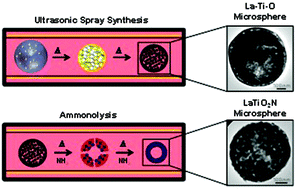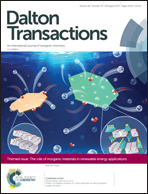Facile synthesis of porous La–Ti–O and LaTiO2N microspheres†
Abstract
Photocatalysts offer an excellent opportunity to shift the global energy landscape from a fossil fuel-dependent paradigm to sustainable and carbon-neutral solar fuels. Oxynitride materials such as LaTiO2N are potential photocatalysts for the water splitting reaction due to their high oxidative stability and their narrow band gaps, which are suitable for visible light absorption. However, facile synthetic routes to metal oxynitrides with controlled morphologies are rare. Ultrasonic spray synthesis (USS) offers a facile method toward complex metal oxides which can potentially be converted to oxynitrides with preservation of the microsphere structures that typify the products from such aerosol routes. Here, La–Ti–O microspheres were facilely produced by USS and converted by ammonolysis to LaTiO2N microspheres with porous shells and hollow interiors. This particle architecture is accounted for by coupling suitable combustion chemistry with the aerosol technique, producing precursor particles where the La3+ and Ti4+ are well-mixed at small length scales; this feature enables preservation of the microsphere morphology during nitridation despite the crystallographic changes that occur. The LaTiO2N microspheres are comparable oxygen evolving photocatalysts to samples produced by conventional solid state methods. These results demonstrate the utility of USS as a facile, potentially scalable route to complex photocatalytic materials and their precursors with distinct morphologies.

- This article is part of the themed collection: The Role of Inorganic Materials in Renewable Energy Applications


 Please wait while we load your content...
Please wait while we load your content...